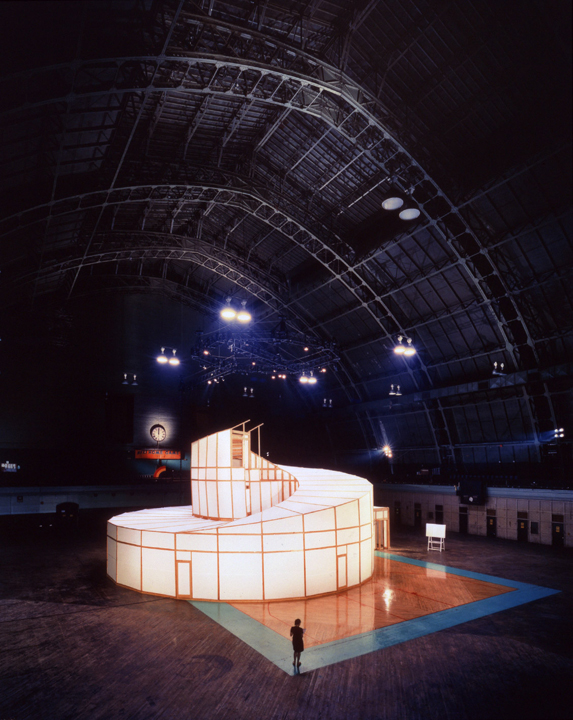Artist:
Ilya Kabakov (born 1933 in Dnepropetrovsk, USSR; died 2023) and Emilia Kabakov (born 1945 in Dnepropetrovsk; lives and works in Long Island, NY).
Description:
“The Palace of Projects, created by husband and wife Ilya and Emilia Kabakov is a spiraling architectural structure forty-feet high and eighty feet in diameter. The nautilus-shaped Palace is constructed of a wood frame covered with stretched, white translucent fabric. Visitors walk through the Palace to explore more than 65 individual ‘projects’ that provide entertaining and engaging suggestions for improving oneself and the world. The Palace of Projects is an archive of utopian ideas and stories told by fictional Soviet citizens. The ‘projects’ include maquettes, paintings, and writings that propose remedies for the challenges of daily life and suggestions for personal growth and improvement.”
—”Ilya and Emilia Kabakov: The Palace of Projects,” Public Art Fund.
“The installation The Palace of Projects consists of two parts. The first part is a pavilion which could be called the Palace of Projects, a two-story structure resembling in layout to a snail and sixty five objects with texts arranged inside of it. Getting a bit ahead of ourselves, it must be said that the main thing in the resolution of this pavilion is served by the arrangement of the lighting—the principle of glowing walls. The entire pavilion is constructed of wooden structures, and the walls and ceiling in it consist of white plastic stretched across them. The plastic is stretched on the frames of the structures only inside of the dwelling, the external parts of the structures remain visible. Light enters into the structure from projectors and bulbs hanging on the outside of the pavilion it passes through the plastic walls and ceiling rather freely. It is understood from the overall concept that the pavilion is built inside of an enormous exhibition hall, representing a so-called building within a building, and the bright lights from the ceiling and the cross-beams of the hall bathe the entire pavilion with unique spots of light. Each room inside the snail has such a special, strange, magical effect.
“But this same light fulfills many artistic functions: it specifically illuminates particular objects, it projects on the walls photos and slides, it shows films on them. The viewer moves inside the snail, beginning from the entrance into it, along a spiral route, and having passed through the entire first floor, reaches a stairway to the second. Here, after passing through the halls one after another, he also reaches the last but also spiral staircase and descends, whereupon he finds himself again in the entrance hall and then exits.
“The objects located along his route, approximately three in each hall, are of the most diverse forms – display cases, tables, screens, drawings on the walls, objects on the floor… All of these are projects in one form or another, each one has its own explanation. In a familiar sense, this is a unique kind of museum, and at the same time everything has a strange academic, didactic quality: each of the sixteen halls has its own special theme, a few halls are united according to a particular principle, the entire spiral installation moving only forward has a specific law of development, even a kind of goal, which can be determined definitively only in the last hall upstairs… Given this whole scholarly approach, the image of the whole and the mood of everything inside and outside are cheery and joyful, slightly like that of a fair, and this all thanks to the glowing patches of light both outside and inside of the snail.”
—Ilya Kabakov and Emilia Kabakov, “Description and Concept of the Palace,” Artangel.


